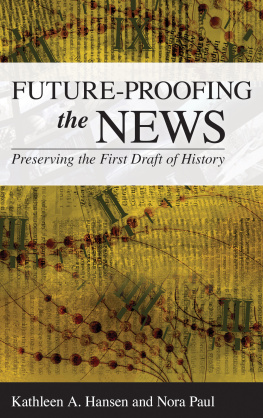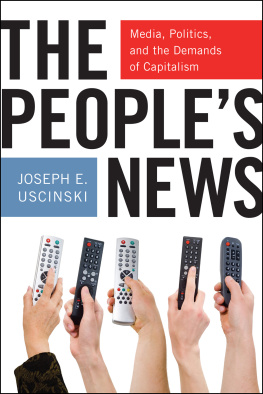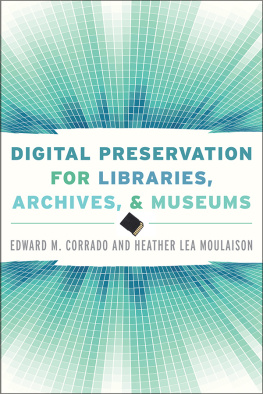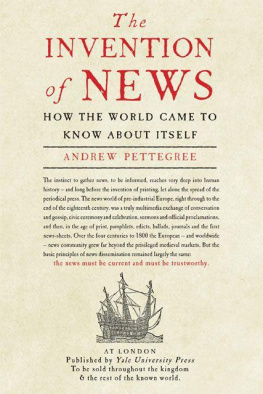Future-Proofing the News
Future-Proofing the News
Preserving the First Draft of History
Kathleen A. Hansen and Nora Paul
ROWMAN & LITTLEFIELD
Lanham Boulder New York London
Published by Rowman & Littlefield
A wholly owned subsidiary of The Rowman & Littlefield Publishing Group, Inc.
4501 Forbes Boulevard, Suite 200, Lanham, Maryland 20706
www.rowman.com
Unit A, Whitacre Mews, 26-34 Stannary Street, London SE11 4AB
Copyright 2017 by Rowman & Littlefield
All rights reserved . No part of this book may be reproduced in any form or by any electronic or mechanical means, including information storage and retrieval systems, without written permission from the publisher, except by a reviewer who may quote passages in a review.
British Library Cataloguing in Publication Information Available
Library of Congress Cataloging-in-Publication Data
Names: Hansen, Kathleen A., author. | Paul, Nora, author.
Title: Future-proofing the news : preserving the first draft of history / Kathleen A. Hansen, Nora Paul.
Description: Lanham : Rowman & Littlefield, [2017] | Includes bibliographical references and index.
Identifiers: LCCN 2016043888 (print) | LCCN 2016057283 (ebook) | ISBN 9781442267121 (cloth : alk. paper) | ISBN 9781442267145 (electronic)
Subjects: LCSH: JournalismUnited StatesHistory. | JournalismTechnological innovationsUnited States. | American newspapersHistory. | NewspapersConservation and restorationUnited States. | Newspaper publishingUnited StatesHistory. | Press lawUnited States.
Classification: LCC PN4855 .H26 2017 (print) | LCC PN4855 (ebook) | DDC 071/.3dc23
LC record available at https://lccn.loc.gov/2016043888
 The paper used in this publication meets the minimum requirements of American National Standard for Information SciencesPermanence of Paper for Printed Library Materials, ANSI/NISO Z39.48-1992.
The paper used in this publication meets the minimum requirements of American National Standard for Information SciencesPermanence of Paper for Printed Library Materials, ANSI/NISO Z39.48-1992.
Printed in the United States of America
For tomorrows seekers of yesterdays news
Preface
News coverage is often described as the first draft of history. From the publication in 1690 of the first colonial newspaper, Publick Occurrences , to the latest tweet, news has been disseminated to inform its audience about what is going on in the world. But preserving yesterdays news for possible future use has been neglected in the day-to-day work of newsmaking. Future-Proofing the News examines the technological, legal, economic, and organizational challenges faced by those concerned with preserving the news.
Over the centuries, as new means of finding, producing, and distributing news were developed, the methods used to ensure access for future generations changed, and new challenges for news content preservation arose. Future-Proofing the News covers the history of news preservation (or lack thereof), the decisions that helped ensure (or doom) its preservation, and the unique preservation issues that each new form of media raised.
All but one copy of Publick Occurrences were destroyed by decree. The wood pulpbased newsprint used for later newspapers crumbled to dust. Early microfilm disintegrates to acid, and decades of microfilmed newspapers have already dissolved in their storage drawers. Early radio and television newscasts were rarely captured, and when they were, the equipment for accessing the content has long been superseded. Sounds and images stored on audio and videotapes fade and become unreadable. The early years of web publication by news organizations were lost by changes in publishing platforms and a false security that everything on the Internet lives forever.
In fifty or one hundred years, what will we be able to retrieve from todays news output? How will we tell the story of this time and place? Will we have better access to news produced in 1817 than news produced in 2017? These are some of the questions Future-Proofing the News aims to answer.
Chapter 1 asks Who Needs Yesterdays News? Chapters 2 through 8 tell the story of how the content from each form of news deliverynewsprint, photojournalism, newsreels, radio, television, and digital newswas or was not preserved, with a detour to describe the news industries digital turn in chapter 7. Chapter 9 delves into the challenges news archive seekers face in gaining access to the materials they need. Chapter 10 lays out some of the technological, legal, and economic issues that must be addressed if we are to have any hope of avoiding historical amnesia.
Future-Proofing the News is written in an accessible style but with thoroughly researched and documented sources. We mined archival and manuscript collections that have not been used for this topic before. In reviewing the key books of media history, it was clear that little attention had been paid to what happened to those news products once they were published, aired, or broadcast.
This book is written to appeal to the general public. It will be surprising to them to learn how at risk the first draft of history really is. We hope that those who rely on access to news as part of their professional activities will understand after reading this book just how tenuous their ongoing access might be. Librarians, archivists, and journalistswhether actively engaged in the work of news preservation or unaware of the issues at stakewill develop a greater appreciation of those issues. Genealogists, media historians, legal scholars, business historians, and others who use news archives for research and scholarship will understand the factors that affect their access to the materials they need.
The idea for Future-Proofing the News grew out of several concerns. The first was the attrition in the ranks of news archivists. With news organizations declining revenue, hard choices have been made about staff reductions. Over the past decade the number of newspapers and broadcast stations with news researchers or librarians has shrunk. In many cases, newsrooms that had robust research and archiving staff now have no one. Who, we wondered, still cares about the newsroom archival assets?
Our second concern was the growing problem of disappearing web content that we encountered as researchers and teachers. We wrote the e-textbook for a course on information strategies for communication professionals. Each semester we had to check the sites we cited and clean out the dead and missing links. The notion that once on the web, always on the web was clearly a fallacy.
Over our professional and academic careers, we had kept our focus so set on the information usage and preservation issues of today that it hadnt occurred to us to look in the rearview mirror. Were news resources ever so highly valued that their preservation was an institutional priority or has news preservation always been an afterthought? How was reporting preserved as new forms of production and distribution arose?
Learning about the varied, inconsistent, sometimes accidental, sometimes obsessive ways that yesterdays news products have been collected has taken us deep into organizational archives and introduced us to colorful characters and dedicated guardians of the past. We have learned about inspiring efforts to preserve certain slices of media history. And we have gained a greater understanding of why the effort to create todays first rough draft of history often precludes attention to adequately preserving yesterdays.
We also quickly realized that we would have to narrow the scope of the topic. Therefore, we deal exclusively with news preservation issues and efforts in the United States. Though we honor the many initiatives undertaken in institutions elsewhere around the world, they are not discussed in this volume. Also, although we cite many useful finding guides for news archives, this book is not intended to serve that function.
Next page







 The paper used in this publication meets the minimum requirements of American National Standard for Information SciencesPermanence of Paper for Printed Library Materials, ANSI/NISO Z39.48-1992.
The paper used in this publication meets the minimum requirements of American National Standard for Information SciencesPermanence of Paper for Printed Library Materials, ANSI/NISO Z39.48-1992.